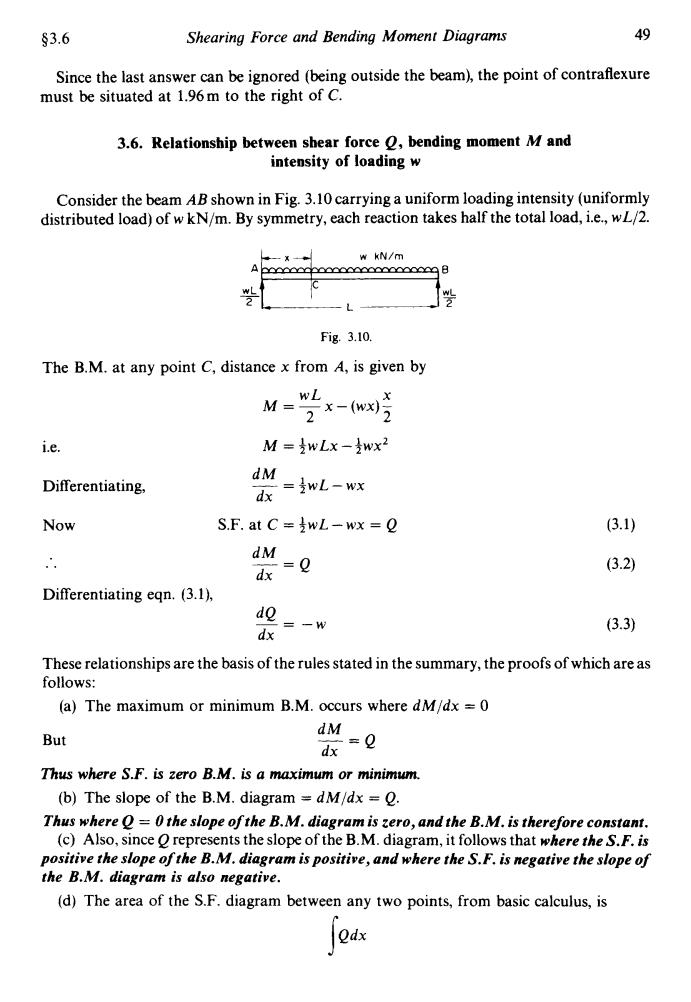正在加载图片...

§3.6 Shearing Force and Bending Moment Diagrams 49 Since the last answer can be ignored(being outside the beam),the point of contraflexure must be situated at 1.96m to the right of C. 3.6.Relationship between shear force Q,bending moment M and intensity of loading w Consider the beam AB shown in Fig.3.10 carrying a uniform loading intensity(uniformly distributed load)of w kN/m.By symmetry,each reaction takes half the total load,i.e.,wL/2. w kN/m Fig.3.10. The B.M.at any point C,distance x from A,is given by M=x-m片 i.e. M=wLx-wx2 dM Differentiating, =wL-wx Now S.F.at C=wL-wx =Q (3.1) dM dx -0 (3.2) Differentiating eqn.(3.1), d№一w (3.3) dx These relationships are the basis of the rules stated in the summary,the proofs of which are as follows: (a)The maximum or minimum B.M.occurs where dM/dx =0 dM But 收=9 Thus where S.F.is zero B.M.is a maximum or minimum. (b)The slope of the B.M.diagram dM/dx =O. Thus where Q=0 the slope of the B.M.diagram is zero,and the B.M.is therefore constant. (c)Also,since O represents the slope of the B.M.diagram,it follows that where the S.F.is positive the slope ofthe B.M.diagram is positive,and where the S.F.is negative the slope of the B.M.diagram is also negative. (d)The area of the S.F.diagram between any two points,from basic calculus,is Qdx$3.6 Shearing Force and Bending Moment Diagrams 49 Since the last answer can be ignored (being outside the beam), the point of contraflexure must be situated at 1.96m to the right of C. 3.6. Relationship between shear force Q, bending moment M and intensity of loading w Consider the beam AB shown in Fig. 3.10 carrying a uniform loading intensity (uniformly distributed load) of w kN/m. By symmetry, each reaction takes half the total load, i.e., wL/2. A 0 - WL EL 2 2 Fig. 3.10. The B.M. at any point C, distance x from A, is given by WL X M = - x - (wx)- 2 2 i.e. M = ~WLX -3.1.’ Differentiating, dM dx --=+wL-wx Now S.F. at C = 4wL - wx = Q (3.1) dM dx -- .. -Q Differentiating eqn. (3.1), 9- - -w dx (3.3) These relationships are the basis of the rules stated in the summary, the proofs of which are as follows: (a) The maximum or minimum B.M. occurs where dM/dx = 0 But dM dx ----=Q Thus where S.F. is zero B.M. is a maximum or minimum. (b) The slope of the B.M. diagram = dM/dx = Q. Thus where Q = 0 the slope of the B.M. diagram is zero, and the B.M. is therefore constant. (c) Also, since Q represents the slope of the B.M. diagram, it follows that where the S.F. is positive the slope of the B.M. diagram is positive, and where the S.F. is negative the slope of the B.M. diagram is also negative. (d) The area of the S.F. diagram between any two points, from basic calculus, is